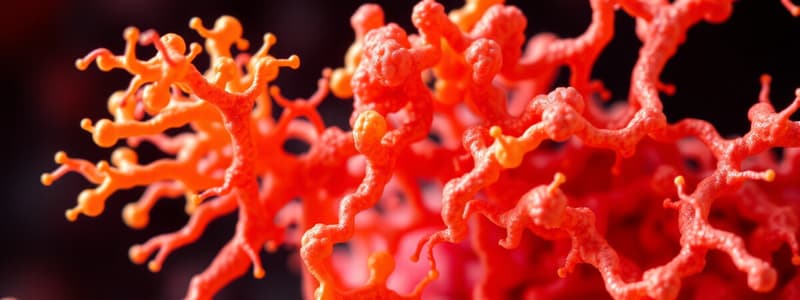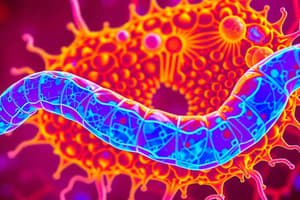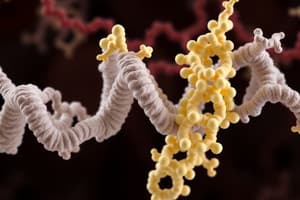Podcast
Questions and Answers
What primarily mediates the entry of cholesterol into cells?
What primarily mediates the entry of cholesterol into cells?
- Simple filtration process via intercellular spaces
- Receptor-mediated endocytosis (correct)
- Transport proteins in the cytoplasm
- Passive diffusion through the membrane
Which component is primarily responsible for organizing LDL particles in the bloodstream?
Which component is primarily responsible for organizing LDL particles in the bloodstream?
- Phospholipids
- Triacylglycerol molecules
- Cholesterol esters
- Apolipoprotein B (correct)
What is the core composition of Low Density Lipoproteins (LDL)?
What is the core composition of Low Density Lipoproteins (LDL)?
- Cholesterol esters and unesterified cholesterol
- Free cholesterol and triglycerides only
- Cholesterol esters with triglycerides and free cholesterol (correct)
- Only phospholipid molecules
How is the lipid monolayer of LDL structured?
How is the lipid monolayer of LDL structured?
What type of endosomes do early endosomes mature into during the endocytic pathway?
What type of endosomes do early endosomes mature into during the endocytic pathway?
Which type of proteins are responsible for catalyzing the formation of disulfide bonds in the ER?
Which type of proteins are responsible for catalyzing the formation of disulfide bonds in the ER?
What is the primary function of chaperones in the endoplasmic reticulum?
What is the primary function of chaperones in the endoplasmic reticulum?
Which amino acid is most commonly glycosylated in the rough ER?
Which amino acid is most commonly glycosylated in the rough ER?
What is a key characteristic of the conditions required for proper protein folding in the ER?
What is a key characteristic of the conditions required for proper protein folding in the ER?
Which protein is NOT a resident ER protein known for assisting in protein folding?
Which protein is NOT a resident ER protein known for assisting in protein folding?
What initiates the glycosylation process in the rough ER?
What initiates the glycosylation process in the rough ER?
Which of the following is a function related to glycosylation in the ER?
Which of the following is a function related to glycosylation in the ER?
Which statement is false regarding the role of chaperones in the ER?
Which statement is false regarding the role of chaperones in the ER?
What role do chaperone proteins play in the endoplasmic reticulum?
What role do chaperone proteins play in the endoplasmic reticulum?
What is the primary consequence of glycosylation at inappropriate sites?
What is the primary consequence of glycosylation at inappropriate sites?
Which of the following enzymes aids in the transfer of oligosaccharides to proteins?
Which of the following enzymes aids in the transfer of oligosaccharides to proteins?
What is a feature of improperly folded proteins within the endoplasmic reticulum?
What is a feature of improperly folded proteins within the endoplasmic reticulum?
What is necessary, in addition to chaperone proteins, for the proper folding of proteins in the ER?
What is necessary, in addition to chaperone proteins, for the proper folding of proteins in the ER?
Why is it important for polypeptides to avoid premature interactions during synthesis?
Why is it important for polypeptides to avoid premature interactions during synthesis?
How do core sugars relate to glycoproteins in the Golgi apparatus?
How do core sugars relate to glycoproteins in the Golgi apparatus?
What happens to improperly folded proteins in the endoplasmic reticulum?
What happens to improperly folded proteins in the endoplasmic reticulum?
What primarily causes the low pH in the lumen of lysosomes?
What primarily causes the low pH in the lumen of lysosomes?
What is the role of the glycosylated proteins in lysosomes?
What is the role of the glycosylated proteins in lysosomes?
Which pathway is NOT described for materials delivery to lysosomes?
Which pathway is NOT described for materials delivery to lysosomes?
What is macropinocytosis primarily used for in cells like cancerous cells?
What is macropinocytosis primarily used for in cells like cancerous cells?
What happens to the materials after hydrolysis in lysosomes?
What happens to the materials after hydrolysis in lysosomes?
What is the role of Rab proteins in relation to transport vesicles?
What is the role of Rab proteins in relation to transport vesicles?
Which characteristic is essential for ensuring a vesicle fuses with the correct compartment?
Which characteristic is essential for ensuring a vesicle fuses with the correct compartment?
What are v-SNAREs and t-SNAREs primarily responsible for?
What are v-SNAREs and t-SNAREs primarily responsible for?
How many types of SNARE proteins are there, as mentioned in the content?
How many types of SNARE proteins are there, as mentioned in the content?
What is the primary function of the tethering proteins in vesicle transport?
What is the primary function of the tethering proteins in vesicle transport?
After a vesicle fuses with a target compartment, what happens to the Rab protein?
After a vesicle fuses with a target compartment, what happens to the Rab protein?
Which component is NOT involved in achieving vesicle and compartment identity?
Which component is NOT involved in achieving vesicle and compartment identity?
What does the interaction between one v-SNARE and three t-SNAREs create?
What does the interaction between one v-SNARE and three t-SNAREs create?
Flashcards are hidden until you start studying
Study Notes
Proteins Present in the ER
- Resident ER proteins are key for proper protein synthesis and folding.
- Translocons and Receptors are involved in protein translocation into the ER lumen.
- Signal Peptidase removes the signal peptide, which directs proteins to the ER.
- Chaperones are essential for proper protein folding.
- BiP, Calnexin, and Calreticulin are some important chaperones found in the ER.
- Proteins of the Unfolded Protein Response (UPR) are crucial for managing cellular stress and preventing misfolded proteins from accumulating.
- Proteins catalyzing disulfide bonds help maintain proper protein structure.
- Glycosylation is the process of adding carbohydrates to proteins.
- Oligosaccharyl Transferase mediates the transfer of the precursor oligosaccharide to the N.
- **The ER provides an environment and processes such as disulfide bond formation and glycosylation to facilitate proper protein folding. **
- Chaperone proteins play a crucial role in ensuring correct protein folding and only properly folded proteins leave the ER.
- Oligosaccharides act as tags indicating the folding state of a protein.
- Improperly folded proteins are exported and degraded in the cytosol.
- Misfolded proteins in the ER trigger the Unfolded Protein Response (UPR).
Endoplasmic Reticulum
- The ER is important for protein modification and lipid biosynthesis.
- The ER provides an environment that promotes the correct folding of proteins.
- The ER functions as a quality control center for proteins.
Intracellular Membrane Traffic
-
Vesicle and compartment identity is achieved by a combination of factors:
- Coat proteins in the vesicle
- Phosphoinositides (PIPs) in the membrane
- Rab proteins present in various organelles
- v-SNARES and t-SNARES in various vesicles and organelles
-
Rab proteins are GTP-binding proteins that guide transport vesicles to their target membranes.
-
Different Rab proteins are located in different organelles.
-
Rab proteins interact with specific effector proteins, ensuring that a vesicle fuses with the correct compartment.
-
SNAREs mediate membrane fusion.
- v-SNARES are located on the vesicle.
- t-SNARES are located on the target compartment.
- SNAREs form a trans-SNARE complex to facilitate vesicle fusion.
Endocytic Pathway
- The endocytic pathway is responsible for transporting materials from the plasma membrane into the cell.
- Early endosomes mature into late endosomes.
- ESCRT protein complexes are involved in forming intralumenal vesicles in multivesicular bodies.
Cholesterol Transport
- The majority of cholesterol is transported in the bloodstream as cholesterol esters within Low-Density Lipoproteins (LDL).
- LDL receptors mediate the binding of LDL to cell surfaces.
- The low pH within the endosome causes the dissociation of LDL from the receptor.
- LDL particles are then transported to lysosomes for degradation.
Lysosomes
- Lysosomes are specialized organelles containing hydrolytic enzymes that degrade various materials.
- The low pH and hydrolytic enzymes within lysosomes are responsible for the destruction of materials.
- The lysosomal membrane is highly glycosylated to protect it from the acidic environment.
- Lysosomes are essential for recycling cellular components and the degradation of foreign materials.
Material Delivery to Lysosomes
- Multiple pathways deliver materials to lysosomes:
- Directly from the cytosol.
- Via the ER-Golgi pathway.
- Through the endocytic pathway.
- Via macropinocytosis.
- Through phagocytosis.
Studying That Suits You
Use AI to generate personalized quizzes and flashcards to suit your learning preferences.




